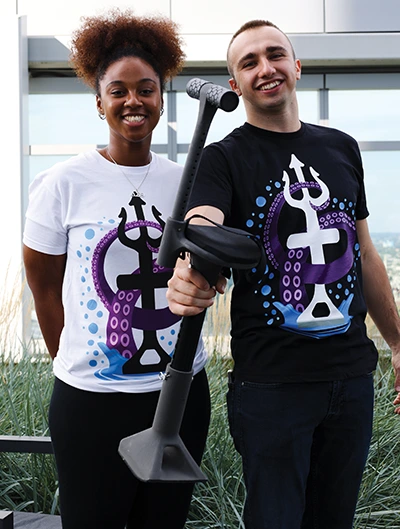
As James Calcagni tells it, the inspiration to build a shower prosthesis came from an eight-year-old kid.
“He said when he goes to a water park, he can’t wear his prosthetic leg down the waterslide because it’s a safety hazard,” says Calcagni, who graduated last spring from Temple University’s engineering school. “So he has to crawl up the ladder on these spiky metal steps on his hands and knees. That really got to me.”
Having grown up with Lyme disease, Calcagni understood firsthand how health challenges can turn everyday tasks into major headaches. And he’d become familiar with the routine aggravations of limb loss during a summer internship at MedEast, one of metro Philadelphia’s largest O&P clinics. So when it was time to develop a senior design project, Calcagni drilled down on the water leg question.
“I went on Instagram and looked up #amputee and just started messaging people and doing interviews,” he says. “And I learned that the shower is a really big problem for people.”
The solution he and design partner Amoyah Gilliam came up with—a durable, lightweight shower leg for below-knee amputees—is drawing kudos inside and outside the limb-loss community. Dubbed the Navigator, the product has won more than $20,000 so far in design contests and pitch competitions. More than two dozen amputee influencers—including at least one Paralympian—have signed up to beta-test the Navigator this spring. Salute 2 Service, a veterans’ support organization, has signed on. And Calcagni’s company, Liquid Limbs, is about to launch a Kickstarter campaign to raise the funds necessary for high-volume production.
“The entire design is based on feedback from the community,” Calcagni says. “People told us they want to be able to wash their residual limb in the shower, so we designed an open socket that lets you wash your residual limb. We designed the foot with holes that let the water drain out, so you don’t have to dump it over.” The Navigator also features anti-slip material on the bottom of the foot, biocompatible material on the weight bearing surface, and easy disassembly so you can slip the leg into your bag for trips to the gym or overnight travel.
“One of the things I love about this design is that it gives people a sense of security and independence,” says Gilliam. She had experimented with water-compatible prosthetics prior to the senior design class, making her and Calcagni ideal collaborators. “I always wanted to work with prosthetics,” she says. “That’s the reason I decided on engineering school.”
The Kickstarter campaign is scheduled to launch on March 22 and run throughout April. If all goes well, Calcagni hopes to be shipping Navigators by the middle of this year. “We already have an above-knee version drawn up,” he says. “We’ll begin prototyping that one as soon as the Navigator’s out the door. We want to meet the needs of everyone in this community.”
“I feel like we’ve already impacted a lot of people,” adds Gilliam. “So there’s no telling what we’ll be able to do going forward.”
Keep your eyes on Liquid Limbs’ website (liquidlimbs.com) and Amplitude’s weekly newsletter for a formal announcement of the Kickstarter launch and instructions for how you can contribute.




